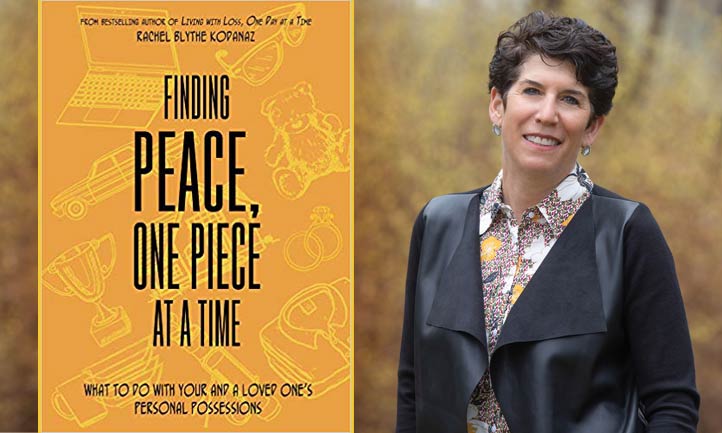Finding Peace, One Piece at a Time
Author: Amy Tucci
In life, we refer to our loved one’s possessions as their stuff and things. In death, they signify forever connections to cherished memories. – Rachel Kodanaz
Rachel Kodanaz, whose husband, Rod, died suddenly when she was 31, knows of what she writes in her new and immensely helpful book, Finding Peace, One Piece at a Time.

Kodanaz found intense meaning and intimacy in Rod’s belongings following his death: his coffee cup, his road race T-shirts, even his toothbrush. For months, she kept his running shoes where he had always left them, right next to the front door.
Anyone who has experienced the loss of a loved one will understand the profound attachment to his or her possessions after death and the emotional difficulties involved in deciding what to do with those items and when to do it.
Like grief, which is a uniquely individual experience, Kodanaz underscores that survivors will have different attachments and responses to their loved one’s possessions. Like grieving, she says, there is no “right” way to do things, no prescribed timeline to clean out the closet, sort through papers, preserve voice mails and social media memories, or to repurpose things in a newly useful way.
While she does not write an exact prescription to follow, her book offers a practical guide for survivors of loss looking to approach the task that most dread while feeling satisfied that the meaningful things of their loved one’s life have ultimately found the right home.
With the “Ten Essentials,” Kodanaz gives useful tips including prioritizing, how to make a game plan (such as moving from right to left in a drawer or room), and how to identify the people who can be useful support systems in the process. But she notes that nothing needs to be done in one day; nor does the process need to be linear. After all, Kodanaz writes, while she began donating Rod’s work suits not long after his death, she kept their daughter’s crib for 13 years before donating it to a charitable organization. The crib had become a symbol of intense meaning; it was where Rod had last kissed their 2-year-old daughter goodbye.
A popular workshop speaker for years at the annual TAPS National Survivor Seminar, Kodanaz in her book recalls attending the seminar and spotting a mother who had repurposed her son’s fatigues, medals, and nametag to make a beautiful day bag that she carried. “The greatest gift from repurposing his belongings was the number of complete strangers asking questions about her son, just as I had. It was truly a special recognition and a great transformation of a uniform that would have otherwise remained in a box in the top of a closet.”
Decluttering has become a popular topic lately, made popular by the KonMari Method,™ which promises to help you organize your sock drawer, home, and your life at the same time by asking yourself if your possessions spark joy.
For Kodanaz, the question about “things” runs much deeper. The question she wants readers to be able to answer after reading her book is, “By keeping this item, how do I keep my love one’s memory alive in a significant and meaningful way?”
To learn more about Rachel and her books, visit Rachel Kodanaz's website.
Book reviewed by Amy Tucci, TAPS Institute for Hope and Healing; President and CEO at Hospice Foundation of America
